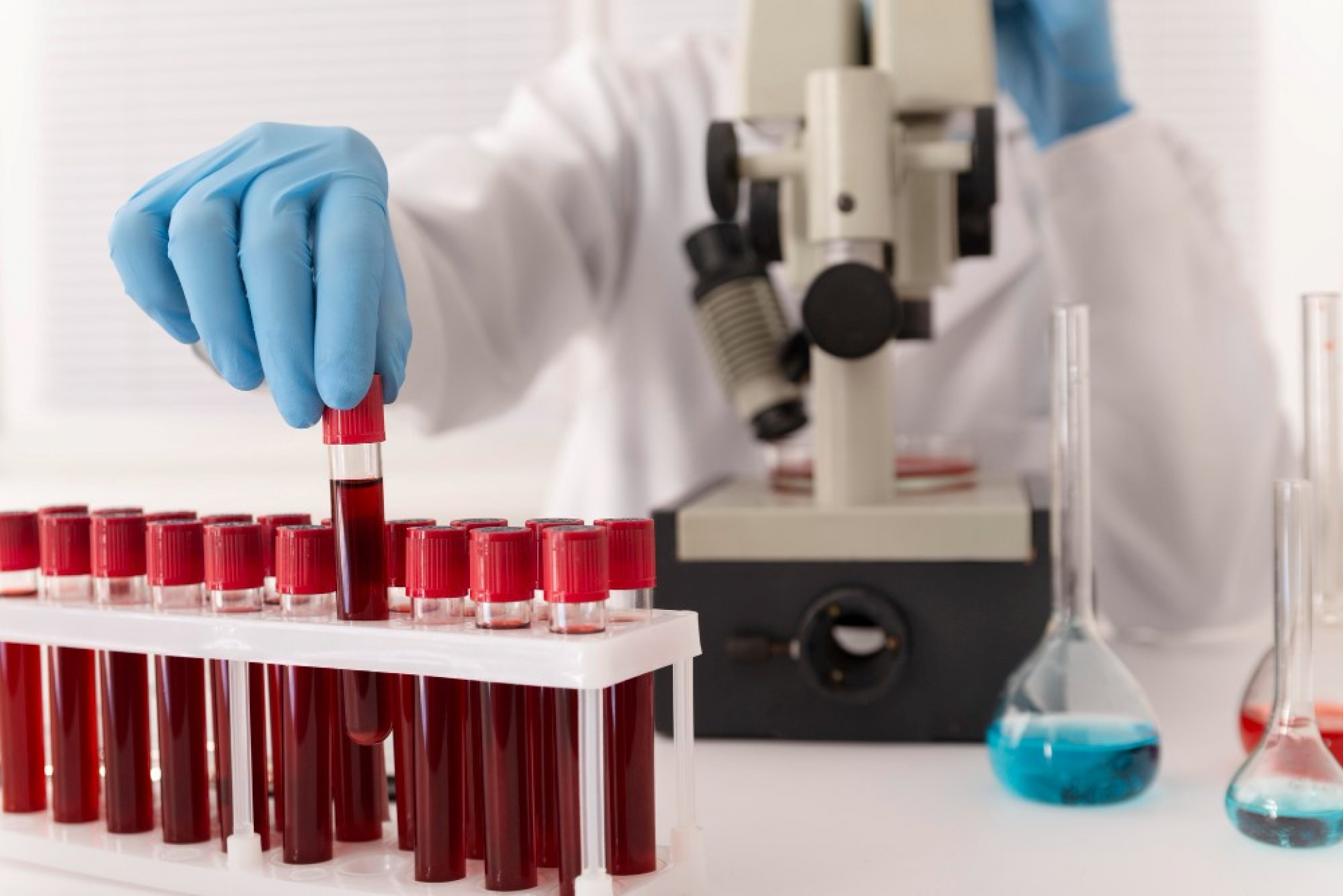Sickle cell disease (SCD) is one of the most common inherited blood disorders worldwide, affecting millions of people each year. It is caused by a genetic mutation in the hemoglobin gene that leads to the production of abnormal hemoglobin known as hemoglobin S, resulting in misshapen, rigid red blood cells. These cells, often described as “sickle-shaped”, can block blood flow, cause pain episodes, and lead to long-term organ damage.
Early sickle cell screening plays a vital role in detecting the condition before symptoms develop. Laboratory-based blood disorder tests, such as the hemoglobin electrophoresis, sickling test, and newborn screening, are essential tools for diagnosing SCD, identifying carriers, and guiding treatment and counseling.
This blog explains how these tests work, why they are critical for genetic screening, and how they support early intervention for individuals and families affected by this inherited anemia.
Understanding Sickle Cell Disease
Sickle cell disease results from a mutation in the gene that encodes the beta-globin subunit of hemoglobin. Normally, hemoglobin (HbA) carries oxygen efficiently throughout the body. In SCD, abnormal hemoglobin variants, primarily hemoglobin S (HbS), alter the shape and flexibility of red blood cells, making them prone to clumping and blocking small blood vessels.
These blockages lead to reduced oxygen delivery, chronic anemia, and repeated episodes of pain known as vaso-occlusive crises. Over time, patients may develop complications involving the spleen, kidneys, lungs, and brain.
Since the disorder follows an autosomal recessive inheritance pattern, a person must inherit two abnormal hemoglobin genes (one from each parent) to develop the disease. Those with one abnormal gene and one normal gene are termed “carriers” or “sickle cell trait” individuals. Carriers usually remain healthy but can pass the defective gene to their offspring, making carrier identification through genetic screening crucial for family planning and community health.
Why Early Sickle Cell Screening Matters
1. Early Diagnosis Saves Lives
According to the Centers for Disease Control and Prevention (CDC), early detection through newborn screening and blood disorder tests allows timely management, which significantly reduces mortality in infants and children with SCD.
2. Carrier Detection and Genetic Counseling
Laboratory tests help identify individuals who carry the hemoglobin variant responsible for SCD. Genetic counseling can then guide parents in making informed reproductive decisions.
3. Disease Monitoring and Preventive Care
Regular sickle cell screening enables clinicians to initiate preventive measures, such as penicillin prophylaxis and vaccination, to reduce infection-related complications.
4. Population-Level Screening
Genetic screening in schools, premarital testing, and high-risk populations helps control the spread of the disease, especially in regions with high carrier prevalence.
Laboratory Workflow for Sickle Cell Screening
The diagnostic workflow for sickle cell screening typically follows a stepwise process:
- Initial Screening – Using the sickling test or solubility test to detect abnormal hemoglobin.
- Confirmatory Testing – Performing hemoglobin electrophoresis or high-performance liquid chromatography (HPLC) to identify specific hemoglobin variants.
- Genetic Analysis – DNA-based testing for mutation confirmation and carrier identification.
- Newborn Screening – Routine testing in infants to enable early detection and management.
The Sickling Test- A Simple Screening Tool
What Is the Sickling Test?
The sickling test is one of the oldest and most cost-effective methods for detecting the presence of sickled red blood cells. It helps screen individuals for possible hemoglobin S presence, particularly in resource-limited settings.
How the Sickling Test Works:
- A small blood sample is mixed with a reducing agent such as sodium metabisulfite, which removes oxygen from hemoglobin.
- In individuals with hemoglobin S, the red blood cells assume a sickle shape when viewed under a microscope.
- If sickling is observed, confirmatory tests such as hemoglobin electrophoresis are performed to identify the specific hemoglobin variant.
Advantages of the Sickling Test:
- Simple and inexpensive.
- Suitable for large-scale sickle cell screening programs.
- Useful for preliminary blood disorder testing in remote or rural areas.
Limitations:
- Cannot distinguish between sickle cell trait and disease.
- False negatives may occur if the blood is oxygen-rich or stored for too long.
Hemoglobin Electrophoresi-: The Gold Standard in Sickle Cell Diagnosis
What Is Hemoglobin Electrophoresis?
The hemoglobin electrophoresis test is the definitive laboratory method used to identify and quantify different hemoglobin variants in a blood sample. It separates hemoglobin types based on their electrical charge and migration patterns through a gel or capillary medium.
Why It Is Essential for Sickle Cell Screening
- Differentiates Between Hemoglobin Types: Detects normal hemoglobin (HbA), hemoglobin S, hemoglobin C, and other variants.
- Confirms Disease or Carrier Status: Distinguishes between individuals with sickle cell disease (HbSS), sickle cell trait (HbAS), or other hemoglobinopathies like HbSC or HbE.
- Guides Clinical Management: Quantitative results help physicians assess disease severity and monitor response to treatments such as hydroxyurea or transfusions.
- Supports Ongoing Health Monitoring: The HbA1c test may also be used alongside hemoglobin electrophoresis to evaluate long-term blood glucose control, especially in patients where hemoglobin variants can affect standard HbA1c interpretation.
Procedure Overview:
- A blood sample is collected and hemolysed to release hemoglobin.
- The hemoglobin is placed on a gel medium and subjected to an electric current.
- Different hemoglobin variants migrate to distinct positions based on charge.
- The pattern is analyzed and compared with known standards to determine the type and proportion of each hemoglobin.
Advantages of Hemoglobin Electrophoresis:
- Highly accurate and reliable.
- Identifies multiple hemoglobin variants simultaneously.
- Used globally for confirmatory sickle cell screening and carrier testing.
Limitations:
- Requires specialized laboratory equipment and trained personnel.
- May not detect rare genetic mutations unless combined with DNA testing.
Newborn Screening- Detecting Sickle Cell Disease at Birth
Why Newborn Screening Matters
The newborn screening test is one of the most important public health measures for early detection of inherited anemia. Since newborns may not show symptoms immediately, this screening ensures that SCD is diagnosed within the first few days of life.
Testing Process:
- A few drops of blood are collected from the baby’s heel (heel-prick test).
- The dried blood spots are analyzed using hemoglobin electrophoresis or HPLC.
- Infants identified with hemoglobin S are referred for confirmatory testing and immediate care.
Benefits of Newborn Screening:
- Enables prompt initiation of antibiotics and vaccination to prevent infection.
- Reduces mortality and morbidity in infants with sickle cell disease.
- Identifies carriers early, enabling long-term genetic screening and counseling for families.
According to the Centers for Disease Control and Prevention (CDC), mandatory newborn screening programs have dramatically improved survival rates among children with SCD in developed countries.
The Role of Genetic Screening in Carrier Identification
Understanding Carrier Status
A carrier (HbAS) has one normal hemoglobin gene (A) and one abnormal gene (S). While they usually don’t experience symptoms, they can pass the defective gene to their offspring.
Importance of Carrier Screening
- Prevention of Inherited Anemia: Couples who are both carriers have a 25% chance of having a child with sickle cell disease.
- Informed Decision-Making: Genetic counseling based on blood disorder test results helps families plan for safe pregnancies.
- Public Health Impact: Carrier identification programs can reduce the prevalence of the disease through awareness and screening initiatives.
Laboratory Tests Used in Genetic Screening:
- Hemoglobin electrophoresis to identify abnormal variants.
- DNA analysis to confirm specific mutations in the beta-globin gene.
Complementary Tests in Sickle Cell Disease Diagnosis
In addition to sickling tests and hemoglobin electrophoresis, several other laboratory investigations help assess the impact of the disease:
- Complete Blood Count (CBC): Measures hemoglobin, hematocrit, and red cell indices to assess anemia severity.
- Reticulocyte Count: Evaluates bone marrow activity and red blood cell turnover.
- Peripheral Smear: Shows sickle-shaped red blood cells and target cells under a microscope.
- High-Performance Liquid Chromatography (HPLC): An advanced, automated technique used alongside electrophoresis for detailed quantification of hemoglobin variants.
These blood disorder tests together form a comprehensive diagnostic panel for sickle cell screening, confirming both disease presence and carrier status.
Public Health Importance of Sickle Cell Screening
Global Burden of Disease
The World Health Organization (WHO) estimates that over 300,000 babies are born each year with sickle cell disease, primarily in sub-Saharan Africa, India, and the Middle East. Without newborn screening and early intervention, many die before their fifth birthday.
Population Screening Programs
Many countries have integrated sickle cell screening into national health systems through:
- Premarital and antenatal testing
- Community genetic screening
- Routine newborn screening
These initiatives, supported by accurate hemoglobin electrophoresis and sickling tests, help control disease prevalence and reduce health inequalities.


